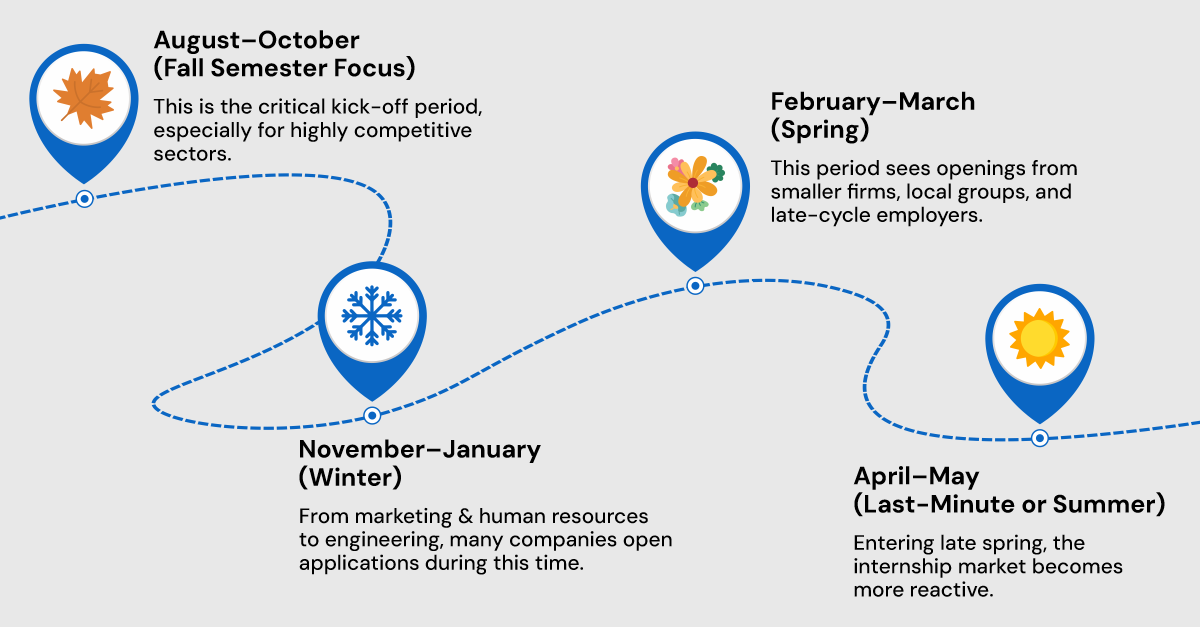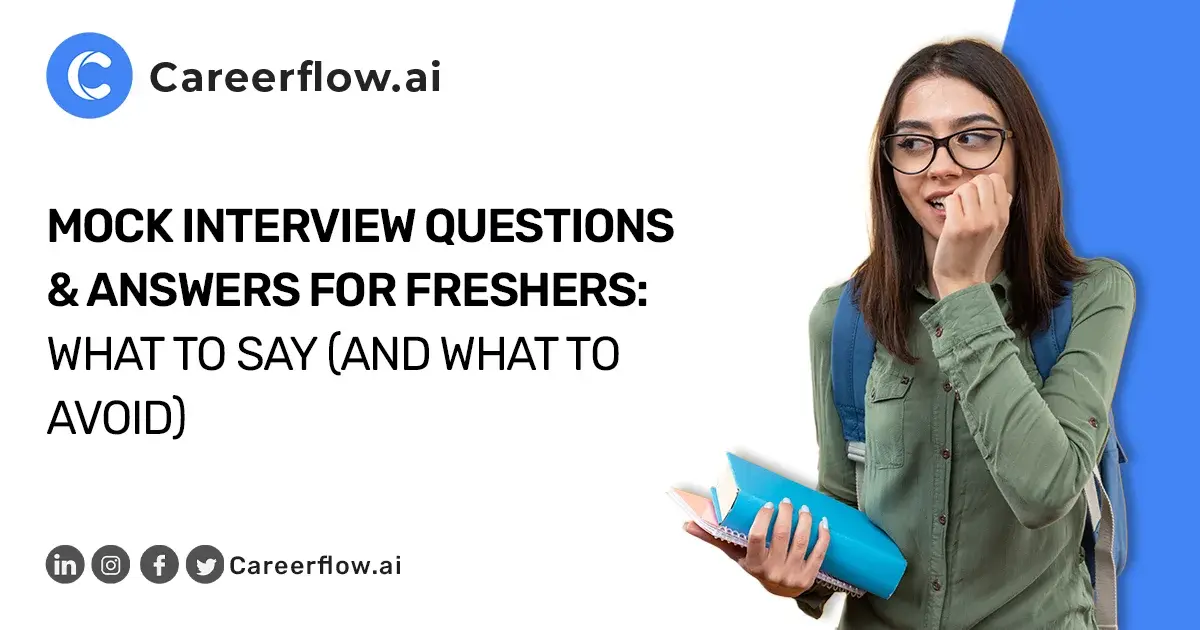Applying for summer internships can often feel like a high-stakes race, leaving students and early-career professionals wondering, "When is the right time to start?" The truth is that securing a coveted summer role isn’t about a last-minute rush; it's a strategic process that begins much earlier than many might think.
This comprehensive guide is designed to clarify the internship application timeline and provide you with a clear roadmap to success. We'll cover everything from when to begin your preparation to when most opportunities typically arise often in the fall prior to the summer internship. You'll also learn how application deadlines can vary significantly across different industries and company sizes, with competitive fields like finance and tech often having deadlines as early as August or September.
Moreover, we’ll equip you with actionable steps to organize your search, expert tips to enhance your applications, and innovative ways to leverage advanced tools for a quicker and more efficient job hunt. Get ready to transform your internship aspirations into reality with a proactive and well-planned approach!
Why Timing Matters for Summer Internships
Securing a summer internship isn't just about having the right skills; it's also profoundly about strategic timing. In highly sought-after sectors such as technology, finance, and media, competition for summer roles can be intense. The most coveted positions typically close their applications a significant 4 to 6 months before the internship even begins, sometimes even earlier. This means if you're aiming for a June start, many top-tier programs are wrapping up applications as early as December or January, and some even earlier in the fall.
Early applicants often have the distinct advantage of securing more interview opportunities and having ample time to thoughtfully respond to feedback, allowing them to refine their approach for subsequent stages. Ultimately, a well-planned application timeline is a powerful tool that not only reduces the stress associated with the job search but also transforms it into a more intentional and successful endeavor, rather than a reactive scramble.
General Timeline for Summer Internship Applications
Navigating the summer internship landscape requires a keen understanding of typical application cycles. While specific dates can vary, here's a refined general timeline to guide your proactive search, ensuring you're always one step ahead:
August–October (Fall Semester Focus)
This is the critical kick-off period, especially for highly competitive sectors. Fortune 500 companies, prestigious investment banks, top-tier tech giants, and leading consulting firms frequently launch their summer internship applications as early as late summer or the very beginning of the fall semester. For students with aspirations in tech, finance, or consulting, this window is important – you should be actively researching, preparing your materials, and submitting applications now, often for programs that fill up on a rolling basis.
November–January (Winter)
This period represents the absolute peak application season for a vast majority of internship opportunities across a diverse range of industries. From marketing and human resources to engineering and non-profits, countless companies open their application portals. While some competitive roles might already be nearing capacity from the fall intake, this is still your prime window to cast a wide net and apply to numerous programs that align with your interests and skills.
February–March (Spring)
As the spring semester commences, you'll still find internship listings, though the landscape shifts. This period is often characterized by postings from smaller to mid-sized companies, local organizations, government agencies, and employers with slightly later hiring cycles. While many of the highly sought-after, early-bird programs may have already filled their rosters, it's absolutely still worthwhile to apply. These opportunities can offer invaluable experience and unique insights, so don't dismiss them.
April–May (Last-Minute or Summer)
Entering late spring, the internship market becomes more reactive. Opportunities available during this time typically include roles filled on a rolling basis, unpaid internships, or positions at startups and smaller businesses that have immediate or quick-turnaround hiring needs. While it's certainly possible to secure an internship during this window, it's crucial not to rely solely on this period. If you've started your search late, keep your eyes peeled and your application materials ready for rapid submission, but understand that the selection of roles may be more limited.
By understanding these cyclical patterns, you can strategically align your preparation and application efforts, significantly increasing your chances of landing a rewarding summer internship.

Internship Deadlines by Industry
Understanding industry-specific application timelines is paramount to a successful internship hunt. While general windows exist, the most competitive sectors operate on accelerated schedules. Here's a refined breakdown to help you strategically target your applications:
- Tech: For highly sought-after internships at technology companies like Google, Meta, Amazon, Apple, and other leading innovators, the application window typically opens in August and can close as early as October or November of the previous year. These positions are often filled on a rolling basis, which means applications are reviewed and offers are extended as they are received. Submitting your application within the first few weeks after the opening is not just important; it is often crucial to be considered for these competitive roles.
- Finance: The finance industry, which includes prestigious investment banks, elite consulting firms, and major accounting firms, follows a strict and highly structured recruitment schedule. Applications for summer internships typically open in August, and the entire process—covering interviews and offers—often concludes by December. This compressed timeline requires early and careful preparation to meet the strict application deadlines.
- Marketing & Media: Companies in the ever-changing marketing and media landscape—including advertising agencies, journalism outlets, social media platforms, and public relations firms—typically start posting their internship opportunities between October and January. While this is the main application window, keep in mind that smaller boutique firms or those with less structured programs may continue to post internship opportunities into late winter or even early spring.
- Healthcare & Nonprofits: Internships in the healthcare sector, such as those in hospitals, research institutions, and nonprofit organizations, often have more flexible application timelines. Typically, you can find internship listings between November and February. However, it's important to note that formal government programs, university-affiliated research internships, and larger healthcare systems may have specific earlier deadlines. Therefore, always verify the application timelines directly with the organizations.
- Startups & Local Businesses: The startup and local business landscape is characterized by greater flexibility and less rigid timelines. Many employers in this sector often don't post their summer internship openings until spring (March to May). They tend to hire on a rolling basis or with short notice, sometimes filling positions only weeks before the internships start. While this presents opportunities for those who apply later, it also requires candidates to be exceptionally responsive and ready to seize an opening quickly.
How to Plan Ahead and Stay Organized
Securing a competitive summer internship is less about luck and more about meticulous planning and unwavering organization. Don't wait until the last minute; your proactive efforts will significantly reduce stress and enhance your chances of landing your ideal role. Here's your elevated process for staying ahead:
- Begin your comprehensive planning process as early as August or September, even if the application submission dates for your target internships are months away. This foundational period allows you to calmly research, set goals, and avoid the inevitable rush and panic that comes with last-minute preparation.
- Develop a detailed list of your target companies and organizations. For each, meticulously record not just their estimated application opening and closing dates, but also specific requirements (e.g., GPA, required skills, portfolio links), preferred qualifications, and any unique application steps. Categorize them by industry and urgency (e.g., "August/September priority," "November push").
- Gone are the days of scattered spreadsheets and forgotten deadlines. Utilize Careerflow’s powerful Job Tracker as your centralized command center. This invaluable tool allows you to systematically manage every aspect of your internship journey: tracking each application you submit, scheduling timely follow-ups, logging interview stages, noting feedback, and ensuring no opportunity slips through the cracks. It transforms a chaotic process into a streamlined, actionable workflow.
- Block out dedicated, non-negotiable weekly time in your schedule. During this time, consistently scour major job boards (like Indeed, Glassdoor), LinkedIn's robust internship section, and critically, your university's career portals.
- Don't wait until an opportunity arises to polish your resume. Start tailoring your resume and crafting compelling cover letters early. Leverage Careerflow’s AI-powered Resume Builder to optimize your resume for applicant tracking systems (ATS) and specific roles. Complement this with the AI Cover Letter Generator to quickly create personalized, impactful letters that highlight your relevant skills and genuine interest, allowing for rapid, high-quality submissions when openings appear.
- Before hitting "submit" on your most important applications, seek external, objective feedback. Connect with your university's career counselors, trusted peers, or mentors who have experience in your target industry. Their insights can help you refine your resume's impact, strengthen your cover letter's narrative, and prepare you for common interview questions, significantly elevating the quality of your overall application package.
Tips to Improve Your Chances of Landing an Internship
Beyond simply applying, a strategic approach significantly enhances your likelihood of securing a valuable summer internship. Incorporate these key tactics to stand out from the crowd:
- Tailor Every Application: Generic applications land in the digital trash. For every single internship you apply to, meticulously customize your resume and cover letter to mirror the job description. Scrutinize the posting for keywords, required skills, and specific responsibilities, then seamlessly weave them into your documents. This not only shows genuine interest but also helps your application pass through Applicant Tracking Systems (ATS).
- Network Strategically: Networking isn't about collecting LinkedIn connections; it's about building genuine relationships. Proactively identify and reach out to employees or alumni at your target companies via LinkedIn. Instead of directly asking for a job, request informational interviews to learn about their roles, the company culture, and their career paths. This provides invaluable insights, helps you tailor your applications, and can potentially lead to referrals.
- Prepare for Interviews Early: Don't wait for an interview invitation to start preparing. As soon as you begin submitting applications, assume you'll get an interview. Begin practicing with mock interviews with a career counselor, mentor, or even a trusted friend. Research common industry-specific and behavioral questions. Being well-prepared for any potential scenario will significantly boost your confidence and performance when the real opportunity arises.
- Apply Broadly: While it's essential to aim for your "dream internships," a smart strategy involves applying broadly. Balance your application list with a mix of:
- Reach Options: Highly competitive roles that would be a stretch but are worth pursuing.
- Target Options: Roles where your qualifications align perfectly with the requirements.
- Safety Options: Internships where you meet or exceed all qualifications, ensuring you have viable alternatives. This balanced approach maximizes your chances of securing at least one offer.
- Follow Up: Your engagement shouldn't end with hitting "submit." Always send brief, personalized thank-you emails after submitting an application and especially after every interview. Reiterate your interest, briefly mention a key takeaway from the conversation, and express gratitude for their time. This small gesture demonstrates professionalism, enthusiasm, and attention to detail.
Use AI Tools to Save Time and Stay Competitive
In today's fast-paced job market, AI-powered tools aren't just a luxury; they're a necessity for staying competitive and efficient.
Resume Optimization: Forget struggling to tailor your resume for every single job. Utilize Careerflow’s Resume Builder to leverage AI for rapid, role-specific resume optimization. Input the job description, and the AI helps you identify key skills and experiences to highlight, ensuring your resume is perfectly aligned with what recruiters are seeking and passes ATS scans effectively.
Resume Optimization: Writing unique cover letters for dozens of applications is time-consuming. Careerflow’s AI Cover Letter Generator can create highly personalized and compelling cover letters in minutes. By inputting your resume and the job description, the AI crafts a tailored letter that speaks directly to the employer's needs, freeing up hours of your valuable time.
Stay on Track: Managing numerous applications across different companies and stages can quickly become overwhelming. Careerflow’s Job Tracker acts as your central hub, allowing you to easily log, manage, and monitor dozens of internship applications simultaneously. From submission dates to interview schedules and follow-up reminders, it ensures nothing falls through the cracks.
Reduce Stress: By automating and streamlining the administrative burdens of job hunting like tailoring documents and tracking applications these AI tools significantly reduce your stress levels. This newfound efficiency allows you to invest your energy where it truly matters: perfecting your interview skills, expanding your professional network, and deeply researching your target companies, ultimately boosting your confidence and overall success.


.webp)






